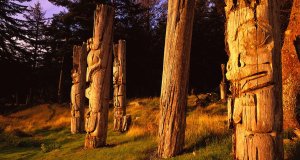
Charles Edenshaw with his engraving tool and a silver bracelet. Photo by Harlan Ingersoll Smith, c. 1890. Canadian Museum of Civilization. 88926
First, I would like to wish all of you a very happy and creative New Year. During the brief break I had between my two teaching terms, I was able to take in an exhibition of Charles Edenshaw’s work that I enjoyed very much. I intend to take my Jewellery Art & Design students there for an art history field trip in a couple of weeks, but I thought I would give you a short review of what I saw.
Charles Edenshaw (1839-1920) lived and worked on Haida Gwaii and was already well-known and recognized in his lifetime. He is considered the foremost Haida artist, a standout among Northwest Coast artists, and is internationally renowned. He left an important legacy, not only in his work, but through his descendants as well, such as his grandson Robert Davidson, an internationally acclaimed artist himself.
This exhibition, organized by the Vancouver Art Gallery (October 26 to February 2, 2014), is the first major survey of this incredibly prolific artist. Over 200 pieces are presented in a wide range of materials and techniques, including metal, wood, argillite, weaving, and carving. On display, are totem poles, canoes, transformation masks, model long houses, chests, platters, bowls, spoons, canes and, of course, jewellery.
I had the opportunity to visit Haida Gwaii twice, a few decades ago. Back then, it was still called Queen Charlotte Islands. It was renamed Haida Gwaii (which means “Islands of the People”), to acknowledge its aboriginal origins, as part of the Reconciliation protocol between the Government of British Columbia and the Haida people. This archipelago, constituted of two main islands surrounded by over a hundred smaller islands, is located on the North coast of British Columbia, just south of Alaska. The overnight crossing from the mainland, 150 km on the rough open seas of the often stormy Hecate Straight gives a taste of how remote and wild this place is. It is home to pristine old growth rainforests and species that are found nowhere else in the world, and to astounding cultural artifacts, like Gwaii Haanas National Park Reserve and its totem poles. On both occasions I was taken not only by the wild beauty of this place, but also by the power and the spirit of the natural world. While there, everything was fodder for my imagination, I always had very vivid dreams, I often felt the urge to draw, to write or to make sculptures or jewellery. Each time, this creative energy fuelled me for several months afterwards.
Charles Edenshaw was remarkable in his ability to harness the spirit of Haida Gwaii, transform it and create magnificent works of art. The exhibition shows his evolution as an artist. We see him early on in his career explore European designs and iconography, and masterfully incorporate them in his work, surprisingly revitalized. We see him draw on his ancestral Haida traditions and stories to build his own distinct vocabulary of shapes and forms. Anyone who has been on the West Coast knows how powerful and exuberant nature is here. Northwest Coast Native art is highly formalized, as if Native artists want to bring some order to this chaotic world. Images are contained in strongly defined ovoids and S and U shapes that are organized into larger forms, all interconnected to fill the entire surface of the piece. Charles Edenshaw’s technique is precise and controlled, whether he is working in wood, argillite or metal. In his silver and gold work, his engraving is astounding. Hand engraving is a demanding technique that requires a lot of finesse and control; curved lines are the most difficult to achieve. In Edenshaw’s work, the lines, despite their precision and their control, are never rigid or contrived. Elegant curves flow, seemingly with ease, connecting the different areas of the design organically. Take for example his series of silver and gold bracelets which features themes that he revisits several times. Each individual piece, thanks to subtle details added or to different inflections of the lines, remains equally fresh and strong. They may be similar pieces, but not copies drained of their energy and spirit.
As I wrote at the start, it is my intention to bring my students to view this show. Nothing can replace the actual experience of being in the presence of this artwork. We do have amazing technology that gives us easy and (mostly) free access to art anywhere anytime, but experiencing that art, just like the environment that inspires it, involves much more than just our visual sense.









